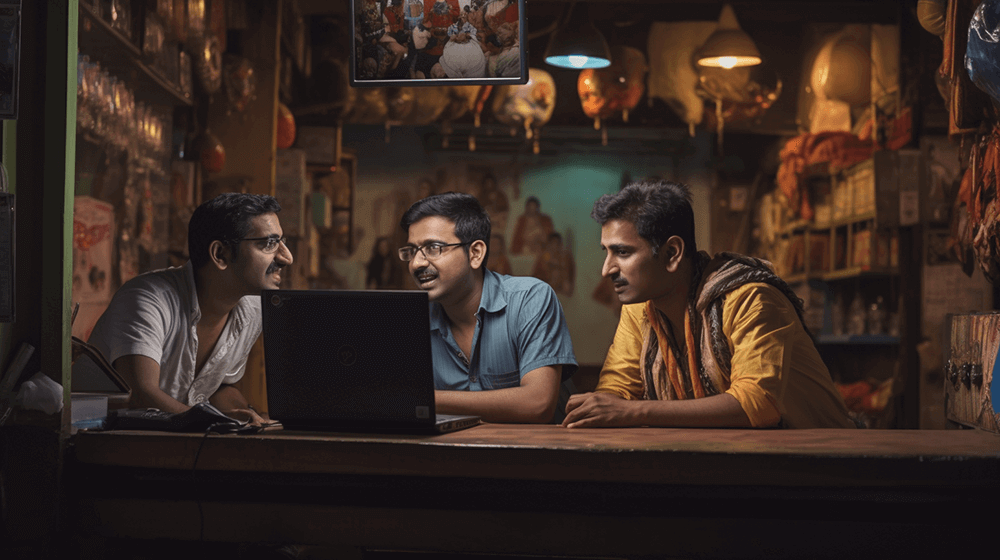- Home
- Casinos
- casinos news
- India's largest gambling states
India's largest gambling states

India is home to many of the world's favorite games. Players exhibit a wide range of gaming preferences, but they all have one thing in common - online gaming is becoming the norm for a mobile-centric society.
Measuring states' share in online gambling is difficult, as mobile gaming has exploded the segment. SevenJackpots' organic traffic data reveals some of the regional characteristics and trends driving the market. They look at the profiles of Indian players from a different perspective from other business consultants.
Key findings of the study
The study aims to illustrate how socioeconomic factors determine in which states and cities in India online gambling has become the main form of entertainment. SevenJackpots' analysis of the data revealed:
Overall level of development as a fundamental factor. Six major cities (and their states) account for nearly 2/3 of all Indian online casino players
Mumbai, Delhi, Kolkata, Chennai, Bangalore, and Hyderabad lead the way. They confirm the importance of technological development and media influence. Pune, Ahmedabad, and Surat also have good scores in terms of gambling prevalence.
Players are closely following global trends, and this is leading to a convergence of gaming behavior tastes with some developed foreign markets.
When combined with industry-wide statistics, the main trends can be easily identified, namely:
- User demographics continue to expand as the internet and mobile devices become more accessible;
- Tech-savvy youth are rapidly adopting mobile technology and electronic payments, which is driving market growth;
- After the period of the Covid-19 pandemic, consumption patterns demonstrate growing confidence in iGaming as a credible choice, not just an alternative.
Urban and rural players are now almost equal in overall numbers. Despite this, gambling experts believe that large centers will continue to gain prominence and drive most of the trends in the online entertainment industry.
Which Indian states stand out for their gambling culture?
Historically, gambling has always been popular in India. Land-based casinos have outlived their heyday and have become less relevant in today's digital economy.
Gambling gives many users easy access to real money games. Offshore gaming platforms expand the market but, more importantly, allow industry professionals to analyze a wider range of players - their preferences, demographics, and gaming behavior.
India, with its huge population, has quickly emerged as one of the most interesting markets for cyber gambling. It is also becoming increasingly urbanized - the urban population is more than 1/3 of the country's total population, with more than 50 cities exceeding 1 million people. Consider that 75% of all Indians are under the age of 45, and this makes young urban Indians a powerful market driver.

The research team analyzed internal data from SevenJackpots' Google Analytics organic traffic over a six-month period. The majority of player visits and online casino registrations come from Maharashtra (17.4%), followed closely by Telangana (9.9%).
Both states are characterized by low poverty rates and high incomes. Maharashtra also has a huge population, and they account for more than 1/4 of the visits of all users. Residents of Mumbai and Pune give more importance to gambling as a way to occupy their time.
They are followed by states that also have significant populations that are mostly below the poverty line - West Bengal and Karnataka, which have 9.3% of casino players. The state of Uttar Pradesh also scores well in terms of relative number of players at 8%. But despite its large population, it is second only to Tamil Nadu and the state of Delhi (8.1%).
From this, it can be concluded that the states in which the top six Indian cities are located provide the majority of gambling - 62.1% of all online casino customers. Their transformation into established gambling communities offers additional prospects: a new generation of players has also begun to adopt a range of gaming products that were somewhat alien to Indian culture just a few years ago.
As further analysis has shown, classic online games in Western-style casinos have become more popular among players. Traditional Indian games are still passé products, but online roulette and slots, especially with a live dealer, are increasingly in demand.
These are also digital gambling products whose popularity is mainly growing in metropolitan cities. Delhi and Mumbai are representative examples of the growth of slots, Hyderabad is contributing to Telangana's popularity in online roulette, and Bengaluru is growing as a player base for desi table games.
Changes in sports betting
In India, sports betting is often considered seasonal, but it is known to be a huge industry. While official channels report less than $2 billion in legal sports betting, analysts and media outlets admit that the total annual turnover reaches up to $100 billion.
As the Indian market matures, local users are increasingly betting on more than just cricket and horse racing. Players have started following popular European and American sports.
Aggregate traffic data provided by one of the leading sports betting review platforms was also analyzed. The traffic of registered users by state was distributed as follows.
- The main difference with online casinos is the growing importance of the states of Telangana (22%) and Karnataka (17%). The former accounts for almost a quarter of all sports betting users despite its size
- Both states are home to India's largest technology centers. Hyderabad and Bengaluru are home to young professionals who are passionate about digital products and globalized services (crypto-payments in gambling, for example, are on the rise);
- Telangana state outlawed gambling and betting in 2017, and Andhra Pradesh followed suit in 2020. Popular gambling and betting became inaccessible within the state, but players found an alternative, as in the states of Uttar Pradesh (7.4%), West Bengal (5.2%), and Madhya Pradesh (4.7%), where online sports betting is not explicitly banned.
Restrictions have made these states rise in the ranking of cyber gambling (especially Telangana).
Players' preferences by the state are also quite clear. Cricket dominates in Maharashtra, while Telangana and Telugu-speaking Andhra Pradesh are into several sports: ISL (soccer) and the Premier Badminton League are popular.
Access from mobile devices
According to the Indian government, the number of mobile internet users will be 810 million in 2022 (second only to China) and is expected to reach 900 million by 2024. The industry report 'Digital Technology in India' shows that internet penetration is on the rise. As expected, Delhi tops the list (around 70%), followed by Kerala. These two states are even ahead of the technologically advanced South. In Karnataka, a major IT hub, the figure is only 42%.
Access is mainly through 4G technology, and smartphones remain the dominant devices. Cheap and easy to use, they are the choice of 97% of all internet subscribers. Some of the world's cheapest data packages are also contributing to market expansion.
Narrowband and wired connections have disappeared, and young desi mobile users have already overtaken China's youth market in 2019. With 17% of global gaming app downloads, India is the largest mobile gaming market. Native fintech solutions have also enabled easy monetization and expanded mobile payment options.
Freemium, in-app, and competitive real-money games further increase the adoption of mobile platforms. Apps do not compete with real-money games but are driving user growth and extending the benefits of mobile casinos.
How do economic and demographic differences affect the gaming industry?
The potential of the Indian online gambling market is certainly related to the growing economy, young population, and gambling culture. But gamers are also globalized and curious - those with disposable income have been shown to appreciate foreign gaming products.
Today, India's leading urban areas have access to top-notch healthcare, entertainment, and sports that are second to none. Despite persistent inequality, megacities are characterized by high levels of service, technological infrastructure, and inevitable consumer culture.
India's wealthiest cities stand out in internet gambling because of their middle class, reportedly numbering around 350 million. This influential user group can afford online entertainment more and more often than other residents.
The shares of internet users across India, according to Statista, show gaps between rural and urban realities, but the figures show that digital inequality across the country is not such a big issue at the moment.

Rural internet users are roughly equal to urban internet users (in terms of total numbers) and are showing strong annual growth of around 18%. Of course, many of them are still stuck in 3G, and some even in 2G, but this only confirms the untapped potential of the market.
There are still far more male Internet users in the country than females. And this gender gap is more pronounced in rural areas than in megacities.
In addition, we know that differences between states inevitably affect consumers' ability and online entertainment availability.
UN reports (2020) show that Andhra Pradesh and Sikkim have improved, while many states - Himachal Pradesh, Meghalaya, Telangana, and Maharashtra - remain stable. The latter two states are also big enough to rank high in cyber gaming, and Meghalaya has passed a law to regulate gambling at the end of 2021.
The SDG index level by state also highlights how aspects such as life expectancy, education, and income levels are important for achieving market maturity. Kerala tops the list of states, followed by Himachal Pradesh and Tamil Nadu, the Union Territories of Chandigarh and Delhi. Among other states, Andhra Pradesh, Goa, Karnataka, Sikkim, Maharashtra, and Telangana perform better than average India.
Not the least of which is the impact of the mainstream media. The government ranks states by media exposure, with Delhi, Kerala, Punjab, Tamil Nadu, Goa, Andhra Pradesh, Telangana, Karnataka, and Maharashtra topping the list. It is easy to see the relationship between media 'consumption' and the propensity to gamble.
Factors shaping online gambling activity
Naturally, there are other factors contributing to the growth of online gambling. Player preferences and gambling culture cannot be changed overnight, but rapid technological evolution and generational dynamics are making a difference.
Ultimately, the combined impact of these factors is affecting the consumption trend in India. The inherent tastes and traditional beliefs of the players always add up and, along with the media, help shape new opportunities.
All this leads to the formation of a healthy online casino market with increased expectations and demands from players. Young and tech-savvy players are driving consumption in major cities and even rural communities. As a result, offshore gambling operators have to take these realities into account and offer more original content localization.
A look at the Indian gambling market
Integrating data with industry reports, we found that the larger and more developed a metropolitan city is, the more prominent and influential it is in the online casino market.
The six largest urban centers - Mumbai, Delhi, Kolkata, Chennai, Bangalore, and Hyderabad - are far outnumbering the others, but they are also starting to catch up. Ahmedabad and Surat, for example, are helping Gujarat gain momentum (6%), and Jaipur is helping Rajasthan (4.4%). Even so, the leading six tier-one metropolitan areas provide the most popular gambling and represent nearly two-thirds of all active online casino customers assessed with our resources.
The natural growth of the digital gambling market will continue to be driven by rising internet penetration, increasing mobile device users, cheaper data packages, and the convenience of cashless payments.


 English (India)
English (India)
 English (Canada)
English (Canada)
 Español (América Latina)
Español (América Latina)
 Español (México)
Español (México)
 Español (Chile)
Español (Chile)
 Español (Perú)
Español (Perú)
 Español (Argentina)
Español (Argentina)
 Español (Colombia)
Español (Colombia)
 Polski (Polska)
Polski (Polska)
 Русский (Россия)
Русский (Россия)
 Русский (Казахстан)
Русский (Казахстан)
 Українська (Україна)
Українська (Україна)